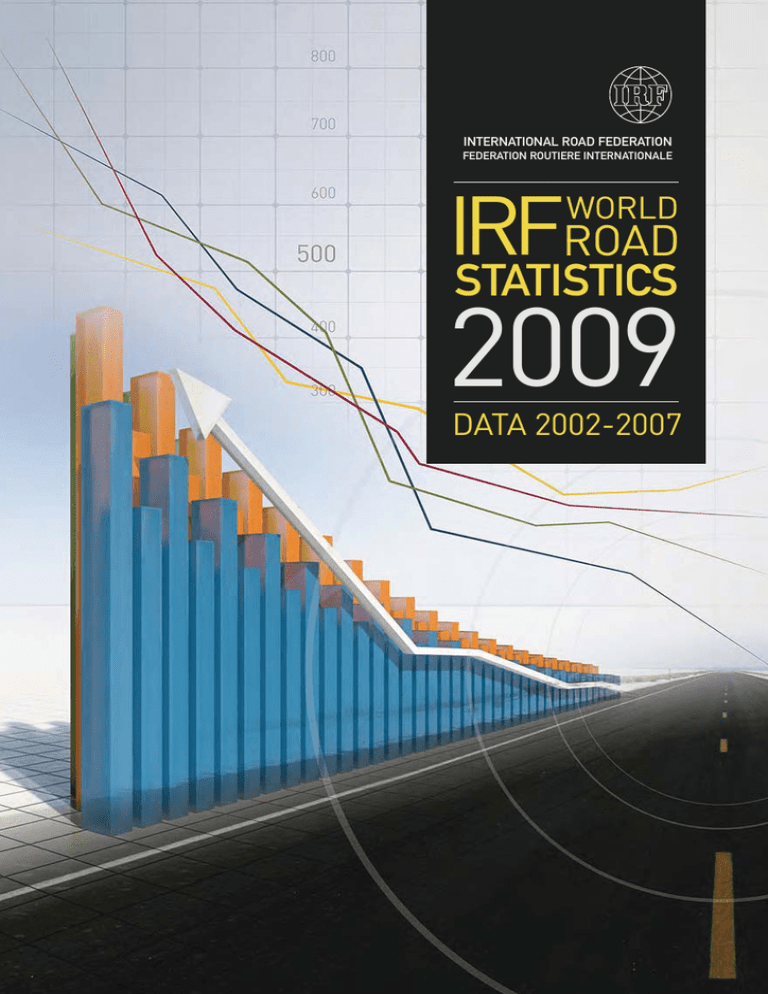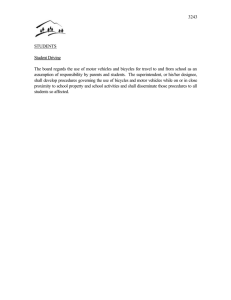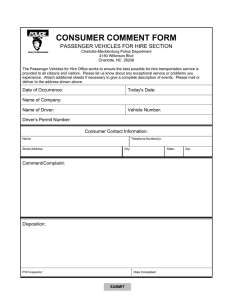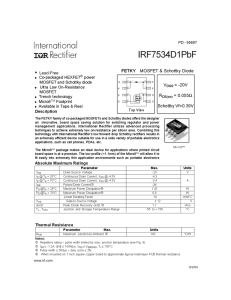
INTERNATIONAL ROAD FEDERATION
FEDERATION ROUTIERE INTERNATIONALE
IRF
ROAD
STATISTICS
WORLD
2009
DATA 2002-2007
This Booklet is an excerpt of the IRF World Road Statistics 2009. It gives data,
graphs and illustrations from selected countries. You can order the full
version of the IRF World Road Statistics 2009 in CD-Rom form at
www.irfnet.org.
Disclaimer
The International Road Federation assumes no liability for use made of the materiel
contained herein by third parties. The data published in the World Road Statistics
have been provided from various sources. Details of these sources are published in
the full version of the IRF World Road Statistics 2009.
Regions, countries and cities are named and designated according to current usage.
No political position is implied or intended. United Nations country designations have
been used in this publication.
IRF Geneva Contact Details
International Road Federation (IRF)
2 Chemin de Blandonnet
CH-1214 Vernier (Geneva)
SWITZERLAND
Tel : (+41) 22 306 02 60
Fax : (+41) 22 306 02 70
E-mail : info@irfnet.org
Statistics : stats@irfnet.org
Website : http://www.irfnet.org
Authors
Kacem Iaych
Vilen Alexeev
Olim Latipov
Copyright
Reproduction strictly prohibited. Extracts may be quoted provided the source “IRF World Road
Statistics 2009” is mentioned.
© IRF Geneva, 1958-2009 – All rights reserved.
TABLE OF CONTENTS
Foreword
Acknowledgements and Sources
04
05
Part 1: Key Indicators for Selected Countries
06
Part 2: Road Networks
Table 2.1: Total Length of road Network per category and country (Km)
Table 2.2: Main Characteristics of road networks per country
Graphs: Road Infrastructure Indicators
09
10
11
Part 3: Road Traffic
Table 3.1: Annual Traffic volume per vehicle category and country (Mio Veh-Km)
Table 3.2: Passenger cars traffic volume per country (Mio Veh-Km) – 2002/2007
Graphs: Road Traffic Indicators
15
15
16
Part 4: Multimodal Traffic Comparisons
Table 4.1: Inland Surface freight transport / mode (Mio T-Km)
Table 4.2: Road freight transport (Mio T-Km) – 2002/2007
Graphs: Multimodal Traffic Indicators
19
19
20
Part 5: Vehicles in Use
Table 5.1: Vehicles in use per category and per country (n)
Table 5.2: Vehicles fleet ratios per country
Graphs: Motorization indicators
25
25
26
Part 6: Road Accidents
Table 6.1: Road accidents figures and rates per country
Table 6.2: Total number of injury accidents per country (n) - 2002/2007
Graphs: Road Safety Indicators
31
31
32
Part 7: Production, Imports, First Registrations and Exports of Motor Vehicles
Table 7.1: Production, imports, first registrations and exports of passenger cars,
per country (n)
Table 7.2: Exports of passenger cars (n) - 2002/2007
Graphs: Motor Vehicle Production Indicators
36
36
37
Part 8: Road Expenditures
Table 8.1: Total road expenditure per administrative levels (Mio $)
Table 8.2: Total road expenditures (Mio $) – 2002/2007
Graphs: Road Expenditure Indicators
41
41
42
Part 9: Energy
Table 9.1: Diesel prices (US$ cent per liter) - 2002/2008
Table 9.2: Road sector energy consumption in ktoe and in percent of total
energy consumption / country - 2006/2007
Graphs: Road and Energy indicators
45
45
46
FOREWORD
Foreword
IRF has been producing high quality and extensive road statistics for over 45 years.
Roads are one of the most vital infrastructure elements of any economy. World Road
Statistics has been a useful tool for road authorities around the world in assessing their
road infrastructure.
From this year, for ecological reasons, the well-known very detailed paper copy of the
World Road Statistics will no longer be published. Instead, a CD-ROM accompanied by
a booklet will be produced. The booklet gives selected key figures, maps, charts and
graphs. The CD-ROM includes detailed statistical reports and tables in Portable Document Format (PDF) and Microsoft Excel format.”.
IRF has put together, once again, a high quality publication which, as in the past, is the
number one statistical reference for governments, companies and associations alike;
helping with investment evaluations, infrastructure planning and sustainable development analyses, and a wide variety of other subjects closely related to road development. Having gained the recognition of major players such as the World Bank, United
Nations agencies, African and Asian Development Banks, the World Resources
Institute, the International Energy Agency, OPEC - and of course consultancies, professional bodies and governments, IRF World Road Statistics continues to fulfill all stakeholders' expectations.
I would like to take this opportunity to thank our national partners for their collaboration and our staff for their innovation and diligence in gathering, verifying, comparing
and presenting a unique collection of data.
Sibylle Rupprecht
Director General
IRF Geneva Programme Centre
04
ACKNOWLEDGEMENTS AND SOURCES
Acknowledgements and Sources
We would like to gratefully acknowledge the role of all national statistics offices, road
administrations, associations and Ministries of Public Works in making the annual IRF’s
“World Road Statistics” (WRS) publication possible.
The support of key collaborators and data providers worldwide has led IRF to extend
the country coverage of road and transport statistics and to provide data of high
quality.
We have compiled data from different sources at international and inter-governmental
levels in order to produce this year’s edition. Herewith is a non-extensive shortlist:
- United Nations Economic Commission for Europe
- United Nations Economic Commission for Africa
- World Bank
- International Monetary Fund
- International Energy Agency
- African Development Bank
- Asian Development Bank
- OECD: Organization for Economic Co-operation and Development
- Central Intelligence Agency, USA
- Eurostat
- ECMT: European Conference of Ministers of Transport
- GTZ: German Technical Cooperation
- OICA: International Organization of Motor Vehicles Manufacturers
- WHO: World Health Organization
05
KEY INDICATORS FOR SELECTED COUNTRIES
06
IRF WORLD ROAD STATISTICS 2009
PART-2
ROAD NETWORK
ROAD NETWORKS
1. Total Road Network: Kilometer length of the road network. The road network
includes “all roads in a given area”.
2. Motorways: Kilometer length of roads, specifically designed and built for motor
traffic, which does not serve properties bordering on it, and which:
(a) is provided, except at special points or temporarily, with separate carriageways
for the two directions of traffic, separated from each other, either by a dividing
strip not intended for traffic, or exceptionally by other means;
(b) does not cross at level with any road, railway or tramway track, or footpath;
(c) is especially sign-posted as a motorway and is reserved for specific categories
of road motor vehicles.
Entry and exit lanes of motorways are included irrespectively of the location of the
signposts. Urban motorways are also included.
3. Highways, main or national roads: Kilometer length of A level roads. "A-level
roads" are roads outside urban areas and other roads outside urban areas. A-level
roads are roads outside urban areas that are not motorways but belong to the
top-level road network. (…) A-level roads are characterized by a comparatively high
quality standard, either non-divided roads with oncoming traffic or similar to motorways. In most countries, these roads are financed by the federal or national government”
4. Secondary or regional roads: Kilometer length of roads that are the main feeder
routes into, and provide the main links between highways, main or national roads.
5. Other roads - UrbanLength of roads within the boundaries of a built-up area,
which is an area with entries and exits especially sign-posted as such
6. Other roads - Rural: Length of all remaining roads in a country not included in
above mentioned categories.
7. Paved roads: Length of all roads that are surfaced with crushed stone (macadam)
and hydrocarbon binder or bituminized agents, with concrete or with cobblestones.
08
ROAD NETWORKS
152,256
27,046
17,858
09
ROAD NETWORKS
10
ROAD NETWORKS
Graphs: Road Infrastructure Indicators.
Europe: Proportion of motorways (%)
Europe: Road networks density (km / km2 land area)
11
ROAD NETWORKS
Total Road Network Distribution / Income Groups (%)
Upper middle income
17%
High income: OECD
46%
Lower middle income
28%
Low income
7%
High income:
nonOECD
2%
Road Density (Km / sq. Km) / Income Groups
Upper middle income
0.14
0.26
Lower middle income
Low income
High income: nonOECD
High income: OECD
12
0.11
0.20
0.47
IRF WORLD ROAD STATISTICS 2009
PART-3
ROAD TRAFFIC
ROAD TRAFFIC
1. Road traffic: Any movement of a road vehicle on a given network.
2. Traffic volume: Weighted average daily flow of each vehicle type on each category
of the road network, as determined from regular national stratified, classified traffic
counts.
3. Estimated traffic volume: If counts are not available, traffic volume is estimated
by dividing the annual consumption of motor vehicle fuel (in liters) used in the country
by the number of vehicles in each category. The result is then multiplied by the average
number of km/litre for that category.
4. Vehicle-kilometre: Unit of measurement representing the movement of a road
motor vehicle over one kilometre.
14
ROAD TRAFFIC
15
ROAD TRAFFIC
Graphs: Road Traffic indicators
Annual traffic volume for passenger cars
per income groups (Mio Veh-Km)
Upper middle income
Lower middle income
Low income
High income: nonOECD
High income: OECD
0
1,000,000
2,000,000
3,000,000
4,000,000
5,000,000
6,000,000
Annual traffic volume for passenger cars
per regions (Mio Veh-Km) (%)
Sub-Saharan Africa
1%
East Asia & Pacific
13%
South Asia
6%
Europe & Central
Asia
29%
North America
47%
Middle East & North
Africa
2%
16
Latin America &
Caribbean
2%
IRF WORLD ROAD STATISTICS 2009
PART-4
MULTIMODAL
TRAFFIC
COMPARISONS
MULTIMODAL TRAFFIC COMPARISONS
1. Inland waterways: Inland waterways are defined as stretches of water, not part
of the sea, over which vessels of a carrying capacity of not less than 50 tonnes can
navigate. This term covers navigable rivers, lakes and canals. Figures for coastal sea
traffic are given as a footnote.
2. Tonne – km: Unit of measure representing the movement over a distance of one
kilometre of one tonne of goods.
3. Passenger-km: Unit of measure representing the transport of one passenger over
a distance of one kilometre. The distance to be taken into consideration should be the
distance actually travelled by the passenger and only on the national network.
18
MULTIMODAL TRAFFIC COMPARISONS
19
MULTIMODAL TRAFFIC COMPARISONS
Graphs: Multimodal Traffic indicators
Road freight transportation (Mio T-KM) per income groups
Upper middle income
Lower middle income
Low income
High income: nonOECD
High income: OECD
0
1,000,000
2,000,000
3,000,000
4,000,000
Road freight transportation (Mio T-Km) per regions (%)
Middle East & North
Africa
0%
Europe & Central
Asia
39%
East Asia & Pacific
26%
Sub-Saharan Africa
0%
South Asia
2%
Latin America &
Caribbean
4%
20
North America
29%
MULTIMODAL TRAFFIC COMPARISONS
Rail freight transportation (Mio T-KM) per income groups
Upper middle income
Lower middle income
Low income
High income: nonOECD
High income: OECD
0
1,000,000
2,000,000
3,000,000
4,000,000
Waterways freight transportation (Mio T-KM) per income groups (%)
Upper middle income
5%
Lower middle income
51%
High income: OECD
43%
Low income
1%
High income:
nonOECD
0%
21
MULTIMODAL TRAFFIC COMPARISONS
Waterways freight transportation (Mio T-KM) per regions (%)
0 10
Sub-Saharan Africa
0 00
South Asia
26 3
North America
Middle East & North
Africa
0 00
Latin America &
Caribbean
0 13
11 39
Europe & Central Asia
62 01
East Asia & Pacific
0
10
20
30
40
50
60
70
Rail freight transportation (Mio T-KM) per regions (%)
0 06
Sub-Saharan Africa
0 07
South Asia
34 69
North America
Middle East & North
Africa
0 44
Latin America &
Caribbean
0 66
33 9
Europe & Central Asia
30 1
East Asia & Pacific
0
22
5
10
15
20
25
30
35
IRF WORLD ROAD STATISTICS 2009
PART-5
VEHICLES IN USE
VEHICLES IN USE
1. Passenger cars: Road motor vehicle, other than a motor cycle, intended for the
carriage of passengers and designed to seat no more than nine persons (including the
driver). The term "passenger car" therefore covers microbars (need no permit to be
driven), taxis and hired passenger cars, provided that they have fewer than ten seats.
2. Buses and motor coaches: Passenger road motor vehicle designed to seat more
than nine persons (incl. driver). Statistics also include mini-buses designed to seat
more than 9 persons (incl. the driver).
3. Lorries and Vans: Rigid road motor vehicle designed, exclusively or primarily, to
carry goods. This category includes vans which are rigid road motor vehicles designed
exclusively or primarily to carry goods with a gross vehicle weight of less than 3,500
kg. This category also includes pick-ups.
4. Road Tractors (semi-trailers): Road motor vehicle designed, exclusively or primarily, to haul other road vehicles which are not power-driven (mainly semi-trailers).
Agricultural tractors are excluded.
5. Motorcycles & mopeds: Two- or three-wheeled road motor vehicles with or
without side-car, including motor scooter with a category. Maximum of 400 kg (900
Ibs) unladen weight.
24
VEHICLES IN USE
25
VEHICLES IN USE
Graphs: Motorization indicators
Total Motor Vehicles / 1’000 people per income groups
Upper middle income
Lower middle income
Low income
High income: nonOECD
High income: OECD
0
100
200
300
400
500
600
700
Total Motor Vehicles / 1’000 people – Top 15 countries
Netherlands Antilles
Monaco
United States
celand
New ealand
atar
runei Darussalam
tal
Australia
Puerto ico
erman
C prus
Spain
rance
Canada
0
26
200
400
600
00
1000
1200
VEHICLES IN USE
Passenger Cars / Income groups (%)
Lower middle income
12%
High income: OECD
63%
High income:
nonOECD
3%
Upper middle income
20%
Low income
2%
Total motor vehicles / geographic regions (%)
Sub-Saharan Africa
2%
South Asia
2%
North America
2 %
Middle East & North
Africa
3%
East Asia & Pacific
20%
Europe & Central
Asia
35%
Latin America &
Caribbean
10%
27
VEHICLES IN USE
Asia: Passenger cars per 1’000 people
South America: Total motor vehicles / 1’000 people
28
IRF WORLD ROAD STATISTICS 2009
PART-6
ROAD ACCIDENTS
ROAD ACCIDENTS
1. Injury accident: Any accident involving at least one road vehicle in motion on a
public road or private road to which the public has right of access, resulting in at least
one injured or killed person.
Included are: Collisions between road vehicles, between road vehicles and pedestrians, between road vehicles and animals or fixed obstacles and with one road vehicle
alone.
Included are collisions between road and rail vehicles. Multi-vehicle collisions are
counted as only one accident provided that any successive collisions happen at very
short intervals.
Injury accident excludes accidents incurring only material damage.
2. Person injured: Any person not killed, but who sustained an injury as result of an
injury accident, normally needing medical treatment.
3. Person killed: Any person killed immediately or dying within 30 days as a result of
an injury accident.
30
ROAD ACCIDENTS
31
ROAD ACCIDENTS
Graphs: Road Safety Indicators
Persons injured in road accidents / geographic regions (%)
Sub-Saharan Africa
4%
South Asia
10%
East Asia & Pacific
24%
North America
2 %
Europe & Central
Asia
21%
Middle East & North
Africa
4%
Latin America &
Caribbean
9%
Persons killed / 10’000 registered vehicles per income groups
75
Upper middle income
23 4
Lower middle income
36 5
Low income
55
High income: nonOECD
15
High income: OECD
0
32
5
10
15
20
25
30
35
40
ROAD ACCIDENTS
Persons killed in road accidents / 100’000 people – 15 highest rates
Lib a
Anguilla
South Africa
Oman
a a hstan
u ana
otswana
Saudi Arabia
Mala sia
rg
epublic
United Arab Emirates
ussian ederation
eli e
ene uela,
Lithuania
0
5
10
15
20
25
30
35
World: Road Fatalities / 100’000 people
33
ROAD ACCIDENTS
Comparison by Income
Group: population, road traffic deaths, and motor vehicles
Population
Upper middle
income
13%
High income:
OECD
15%
High income:
nonOECD
1%
Low income
18%
Lower middle
income
53%
Road traffic deaths
High income:
OECD
15%
High income:
nonOECD
2%
Upper middle
income
23%
Low income
10%
Lower middle
income
50%
Total motor vehicles
Upper middle
income
19%
Lower middle
income
13%
Low income
2%
High income:
nonOECD
3%
34
High income:
OECD
63%
IRF WORLD ROAD STATISTICS 2009
PART-7
PRODUCTION,
IMPORTS, FIRST
REGISTRATIONS
& EXPORTS OF
MOTOR VEHICLES
PRODUCTION, IMPORTS, FIRST REGISTRATIONS AND EXPORTS OF MOTOR VEHICLES
36
PRODUCTION, IMPORTS, FIRST REGISTRATIONS AND EXPORTS OF MOTOR VEHICLES
Graphs: Motor vehicle production indicators
First registration of passenger cars per Income group
Upper middle income
Lower middle income
Low income
High income: nonOECD
High income: OECD
0
5,000,000
10,000,000
15,000,000
20,000,000
25,000,000
First registration of passenger cars – Top 15 countries
ussian ederation
China
apan
erman
United ingdom
rance
Spain
Poland
orea,
epublic of
Australia
Me ico
ndia
elgium
Mala sia
South Africa
0
5,000,000
10,000,000
15,000,000
20,000,000
25,000,000
37
PRODUCTION, IMPORTS, FIRST REGISTRATIONS AND EXPORTS OF MOTOR VEHICLES
Production of passenger cars – Top 15 countries
apan
China
erman
United States
orea,
epublic of
rance
ra il
Spain
United ingdom
Me ico
Canada
ussian ederation
ran
tal
ur e
0
2,000,000
4,000,000
6,000,000
,000,000
10,000,000
Export of passenger cars – Top 15 countries
Poland
apan
orea,
epublic of
Spain
rance
United States
elgium
ur e
Sweden
Slo enia
Slo a ia
Australia
Portugal
Austria
South Africa
0
38
2,000,000
4,000,000
6,000,000
,000,000
IRF WORLD ROAD STATISTICS 2009
PART-8
ROAD EXPENDITURES
ROAD EXPENDITURES
1. Road expenditures: Includes expenditures on constructions, maintenance, administrative costs and research.
2. Construction expenditures: Includes expenditures on new construction and
extension of existing roads, including reconstruction, renewal and major repairs.
3. Maintenance expenditures: Expenditures for keeping roads in working order.
4. Expenditures by administrative levels: Sums paid by way of subvention by the
Central Government to a Regional or Local Government, or by the latter to a local
Government or municipality, are shown as expenditure of the government receiving
the subvention so that this relates to their responsibility for the network.
5. Currency exchange: Exchange rate for national currency to Dollar on 31st December of each year.
40
ROAD EXPENDITURES
41
42
St
ussia
0%
Austria
Swit erland
Spain
renadines
New ealand
incent &
U raine
oli ia
Malt a
Australia
A erbai an
Ecuador
Swa iland
Cambodia
hana
Slo enia
Lat ia
orea
arbados
elgium
Croatia
epublic
Lao PD
Sout h
C ech
Lib a
ambia
1%
2%
3%
4%
5%
6%
7%
%
9%
10%
11%
12%
Graphs: Road Expenditure Indicators
Total Road Expenditure (% of GDP) – Top 25 countries
13%
14%
15%
ROAD EXPENDITURES
IRF WORLD ROAD STATISTICS 2009
PART-9
ENERGY
ENERGY
Fuel prices figures are collected using the following sources:
o International fuel prices 2008 – 6th edition – German Technical
Cooperation “GTZ” ;
o World Development Indicators 2009 – World Bank.
Data on the road sector energy consumption are collected by the International Energy
Agency, Statistics Division.
44
ENERGY
45
ENERGY
Graphs: Road and Energy indicators
Road sector total energy consumption 2007 / Income groups (%)
High income: OECD
59%
Upper middle income
16%
Lower middle income
1 %
High income:
nonOECD
4%
Low income
3%
Road sector total energy consumption in percentage of the
total primary energy supply (%) per income groups
13 61
Upper middle income
Lower middle income
Low income
High income: nonOECD
High income: OECD
46
24
0
14 44
19 59
INTERNATIONAL ROAD FEDERATION
FEDERATION ROUTIERE INTERNATIONALE
WWW.IRFNET.ORG
The International Road Federation (IRF) is a nongovernmental, not-for-profit organisation with the mission to encourage and promote development and maintenance of
better, safer and more sustainable roads and road networks. Working together with its
members and associates, the IRF promotes social and economic benefits that flow from
well-planned and environmentally sound road transport networks. It helps put in place
technological solutions and management practices that provide maximum economic
and social returns from national road investments.
Since its foundation in 1948, the International Road Federation has had many successes
and has much to be proud of. Not only has it been instrumental in providing leadership
for global road infrastructure development, but it also brought road professionals and
people of the world together in a common mission in a way that no other road organisation could.
The International Road Federation has a major role to play in all aspects of road policy
and development worldwide:
t'PSHPWFSONFOUTBOEmOBODJBMJOTUJUVUJPOTUIFIRF provides a wide base of
expertise for planning road development strategy and policy.
t'PSJUTNFNCFSTUIFIRF is a business network, a link to external institutions and
agencies, such as the United Nations and the European Union, and a business
card of introduction to government officials and decision makers.
t5ISPVHIPVUUIFDPNNVOJUZPGSPBEQSPGFTTJPOBMTUIFIRF is a source of support
and information for national road associations, advocacy groups, companies and
institutions dedicated to the development of road infrastructure.
With a wide network across over eighty countries on six continents, the International
Road Federation believes that it can make a difference by providing best practices and
expert advice to today’s multi-faceted world of transport. Active in the advocacy of all
issues relevant to the road industry, from financing to technology and from development
to safety, it serves as a catalyst for public and private partnership to organise, promote
and develop international road programmes.
IRF’s history is rich in events and has been closely linked to the development of the
world economies. Facing new challenges every decade, the IRF has never stopped
promoting efficient, well-maintained, safe, environmentally and economically
sustainable roads and road networks.
Contact us at info@irfnet.orgJGZPVXJTIGVSUIFSJOGPSNBUJPOPSMFBSOIPXUPKPJOUIF*3'
International Road Federation (IRF)
2 chemin de Blandonnet, 1214 Vernier / Geneva, Switzerland
5FM'BY




